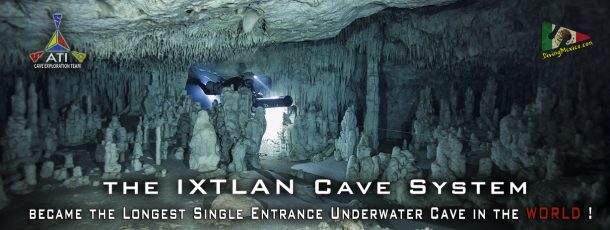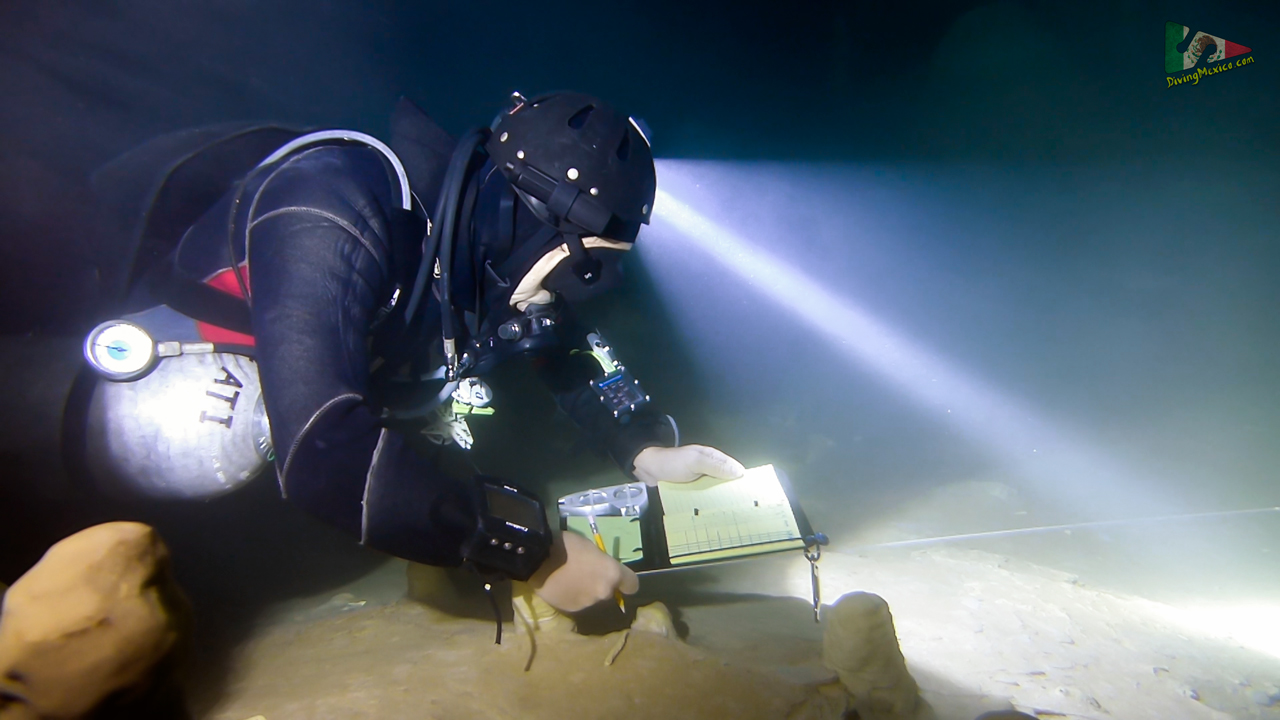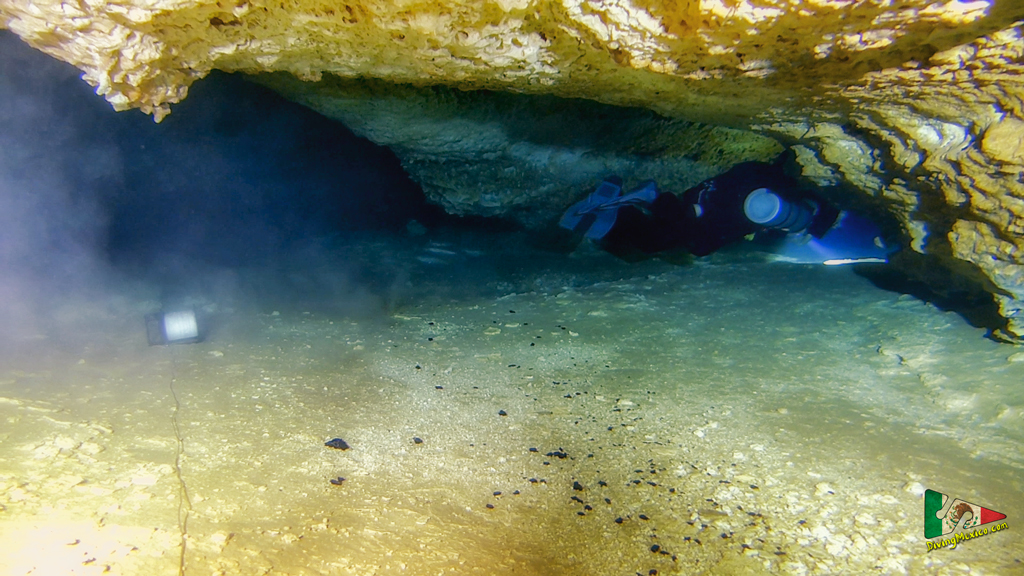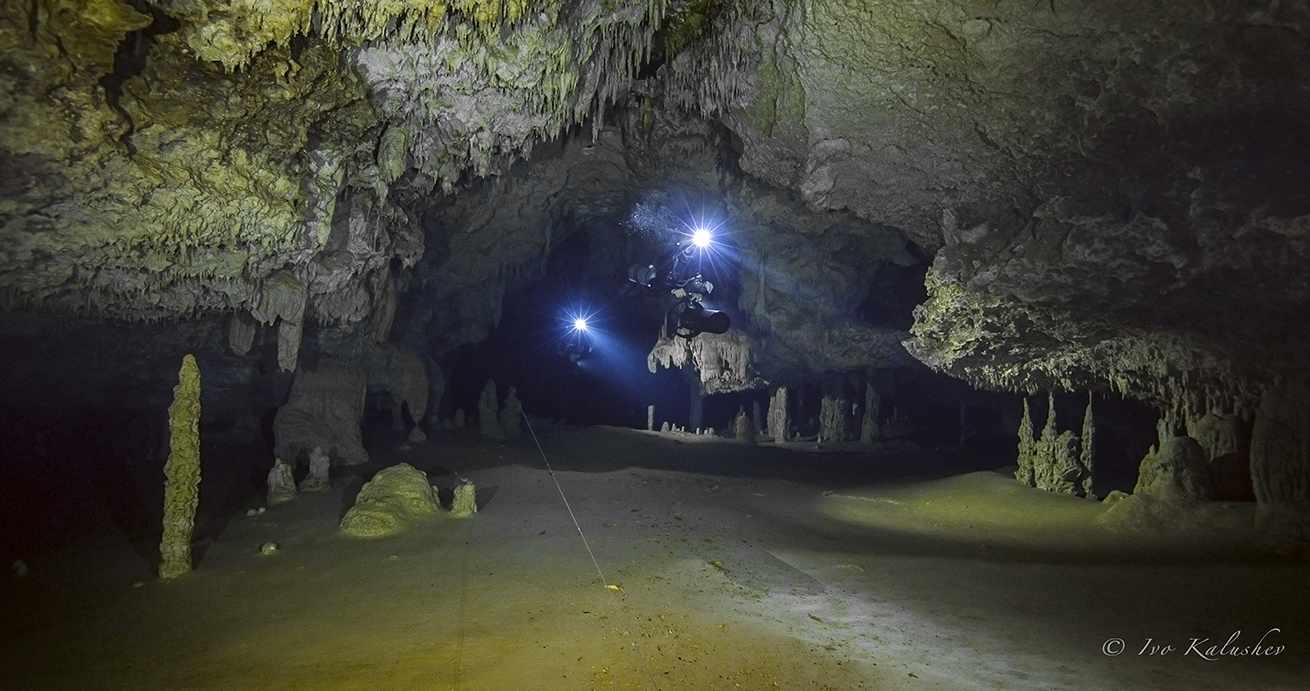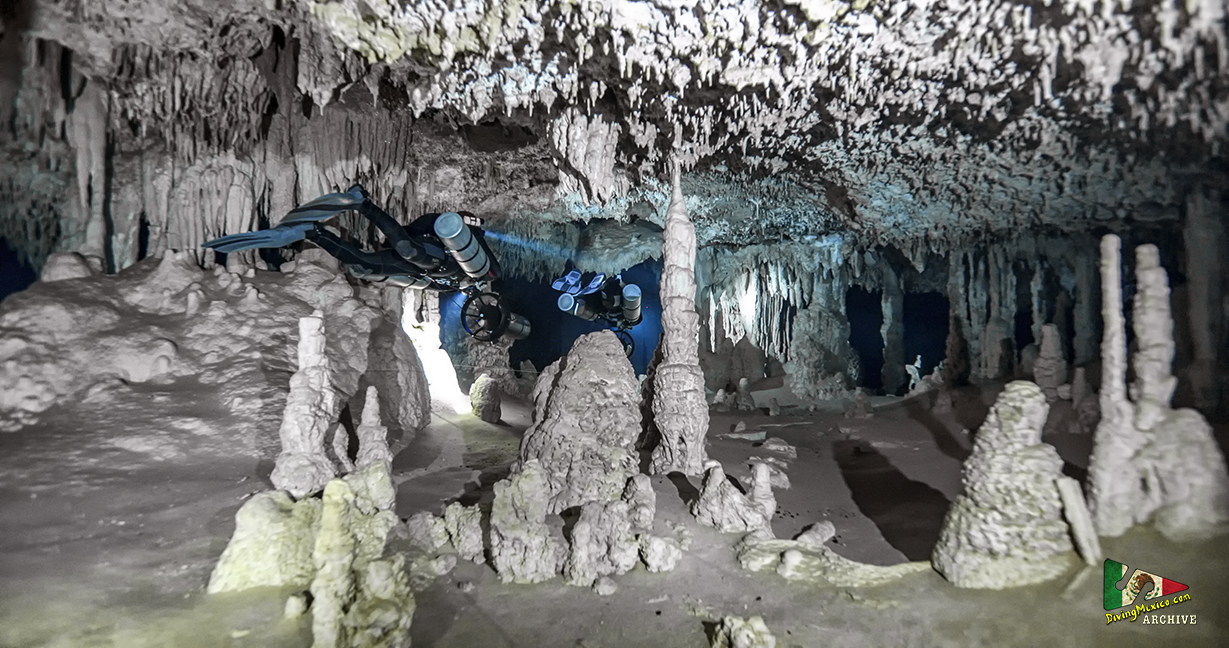The Ixtlan Cave Exploration Project
The Ixtlan Cave Exploration Project
The making of the longest single-entrance underwater cave in the world
by Ivo Kalushev, leader of the ATI Cave Exploration Team – Yucatan, Mexico
28 December, 2017 ( * updated January 2021 )
Ivo is the director the the speleology division of the EMKGI, leader of the ATI Cave Exploretion team of the E.Martel Speleology Club, with 30 years of cave exploration and teaching experience as a Technical Speleology and Emergency Cave Rescue Instructor Trainer and as the exploration team leader on several significant European long-term projects, Ivo is the owner of the Diving Mexico cave diving school. He currently teaches only specialized exploration-specific courses to certified cave divers and instructors.
Ivo surveying, Ixtlan cave, circa 2013
Over the years I was asked repeatedly to tell the story of the Ixtlan Cave discovery and exploration. I am not a very good writer and English is not my native tongue, and the whole story would make for a very big book, but maybe this short article could be inspiring to someone. I hope you enjoy it.
The discovery
Everything started in a simple way. On a warm and humid day in early 2013 we were led by a group of Mayan guides to yet another place in the Yucatan jungle. We had been looking for a cenote property to buy with very specific requirements – I was looking at areas where geologically it was possible for single entrance caves to exist. There are not many such areas in the peninsula, so we had been going through these experiences for months. Every trip started with great promises and we did the inevitable arduous and sweaty jungle hike, in the end only to find ourselves in front of yet another totally disappointing swamp in the jungle. I knew the routine by heart, my expectations were zero…
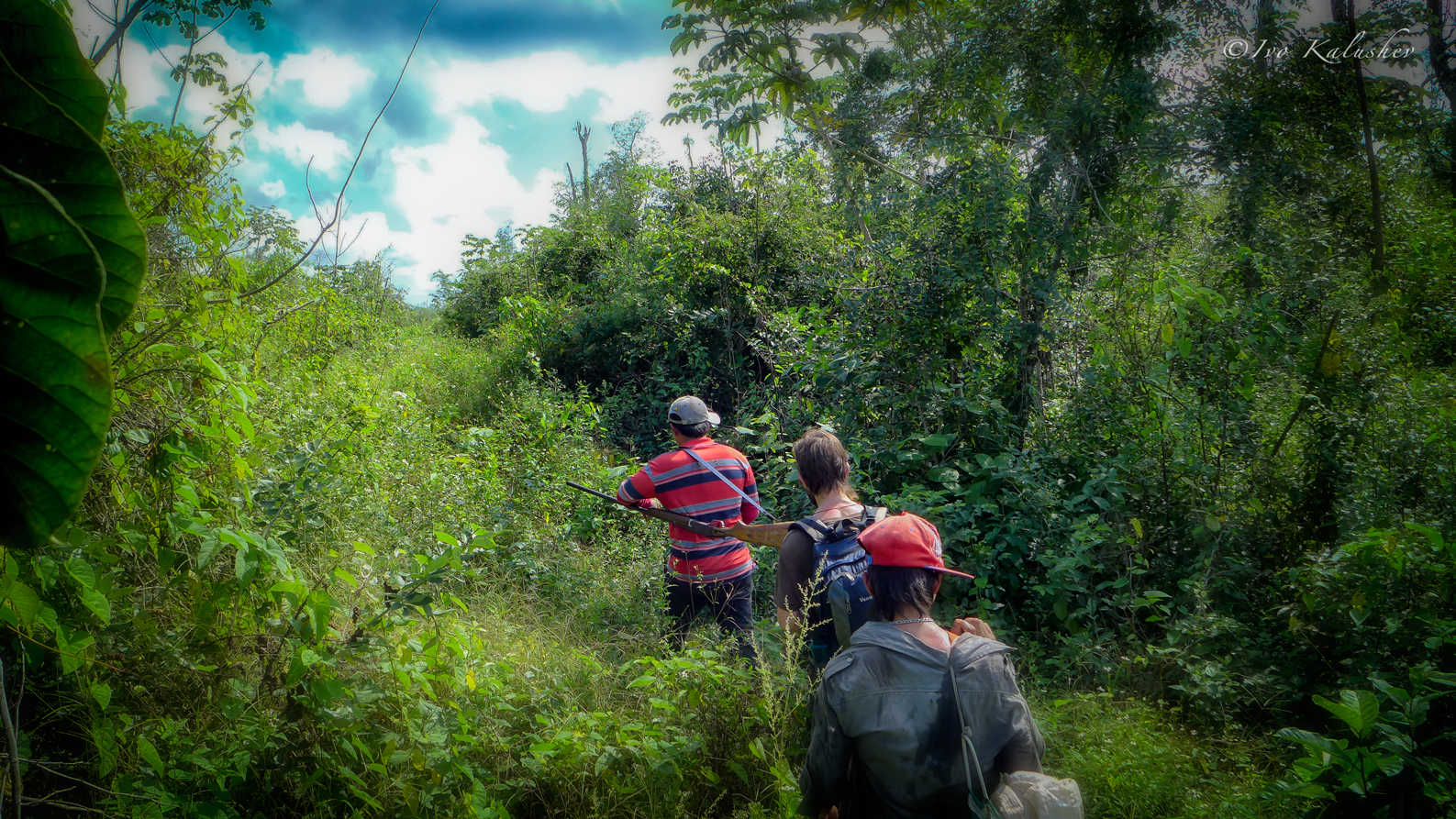
With our Mayan guides on the way to the next cenote…
This time however it was different. Our guides were nervous – it was obvious that they thought we would not like the place even before we reached there. This had not happened before – Mayans don’t do that, they would normally lie about everything just to get you to go somewhere. This day the mood was wrong from the beginning. Something was about to happen but we didn’t know what. We went to an abandoned and fully overgrown place in the jungle, many miles away from the main highway. At first there seemed to be nothing there. And then I saw the collapse. We were on the edge of something spectacular – the roof of an immense cave passage had given up in ancient times and we were standing in front of a ravine in the otherwise flat jungle. It was about 70 meters wide by 300+ meters long and 20 meters deep. On one side of it there was a cave entrance – and not a small one, a huge one. Our guides wanted to show us the lake inside and were very edgy that we may not like it. Little did they know that I already knew what was there – the virgin cave we have been looking for. I started caving when I was 12 years old and this became my life passion. From the first second I knew very well what I was looking at.
Deyan at the entrance to Ixtlan – the day we first saw it
The pool of water inside the cave entrance was not spectacular. Fully overgrown, 20cm. deep swampy water, no current, no obvious underwater cave passage, huge smelly and loud bat colony. But the auspiciousness was palpable – I knew that our search was over. Our guides disappeared with no explanation about their odd behavior, but not before we secured the contacts of the property owner. When I called him he said there was no cave there, but we were welcome to look.
The very next day we were there alone with diving equipment ready to search every inch of the pool for the underwater cave entrance. And indeed there it was – a small opening near the right wall, over a mountain of silt, and big enough for someone to pass with sidemount gear on. My mind was telling me that we were about to enter something gigantic – all the right signs were there. But my past experience was making me quite nervous – sometimes the greatest cave passages end abruptly, with no logic or obvious reason. This place could be just another huge disappointment.
Me and Deyan put our gear in silence. Then we carefully inched our way inside. The cave opened up a little bit after the first 10 meters, but you could not see too far ahead. There was something in the distance which looked like another wall of formations. I expected it to end any minute, at every small turn. We passed through a narrow canyon-like passage we later termed “The Gate”. And then suddenly it was almost all black ahead and around us. We had just entered a cave room with no defined walls or boundaries. There were only column formations as far as our lights allowed us to see, and between them it just continued everywhere. We were just hanging there, looking at each other and at the cave. It did not align even with our most optimistic expectations. This was something else – we knew that we were looking at something unique, something we had not yet seen in Mexico, or anywhere. There was no arrogance, we were just deeply humbled by it.
Deyan entering “The Gate” in Ixtlan, 2013
The start of the Ixtlan cave exploration project
A couple of months later the whole place was ours. We named it “Ixtlan” – in honor of the great work done by Carlos Castaneda. We bought a huge piece of land containing the cave entrance and everything of value around it, and the real work began. We wanted to explore the cave, but we also needed to clean the cenote, to build living quarter – it was a formidable undertaking which would take nearly five years to complete with the constant hard work of more than 10 people. At the same time I wanted to develop our other properties, and to start the most ambitious underwater cave exploration project imaginable. We needed a lot of financing for all this, we needed much more equipment, our own gas filling station, complex logistics. And at the same time we didn’t feel like asking for collaboration from any of the other cave diving groups active in Mexico – everything here was just too commercialized for my taste, and apart from us in the state unfortunately there was literally no one with a speleology background, knowledge and experience. I knew that no one could catch up if we started to explore properly. It was a project like no other and hectic was surely a weak word to describe the beginnings of it.
The first dives
Me and Deyan started doing daily dives in the cave. We laid line carefully, checking everything, marking every prospective lead. What we had seen on our first dive was nothing. It just went everywhere. The first few kilometers of line also went just like that. We had to find a cheap source of quality line, of hundreds of cave arrows, the local cave divers and explorers we asked were not helpful even with such trivial information. This only strengthened my resolve to create and fund a truly independent cave exploration project and to work only with close friends on it. This certainly turned out to be a right decision. When the days became months and the months became the first year of exploration, our cave diving skills and experience had improved drastically. The length of our dives was also reaching 3+ hours.The cave was already more than 6 kilometers long, and was already the longest single entrance underwater cave in the world – something I didn’t know back then, and something I wouldn’t have cared about even if i did. At that time we started to have a more serious concern – the cold.
Ixtlan Cave – the first 50 meters, 2013
Our first real challenge – the cold
The long exploration dives started to take their toll for the whole team. In the beginning we started diving with 7mm wetsuits. The water in Ixtlan is 25C – very warm, and it was all great while it lasted. Little by little however we started feeling colder and colder at the end of our dives. Something weird was happening, our bodies somehow were accumulating stress, and cold. We learned the hard way that daily exploration dives over long periods of time were no joke. But we didn’t want to stop. First we added Lavacore undersuits. This created the equivalent of 10mm of insulation and stabilized things for a couple of months. Then we had to add another 5mm of neoprene vests, bringing the total to 15mm of insulation. Then – silk shirts. Even then – and this was sometime during the second year – all this was no longer enough. We emerged from our dives blue and shaking. This was not good – at that point I was seriously concerned that we may need to stop. There was only one option of course – dry suits. We got some to test out, it was a complete disaster. I realized that I had developed a style of diving and have reached a level of skill where I was constantly negotiating 3D narrow passages and restrictions. Despite the fact that I was very comfortable with dry suit manipulation and diving, it quickly became apparent that this type of exploration was not possible with a dry suit. Suddenly half of our cave became inaccessible for us. Clearly this was not a solution. We had to somehow stick to wetsuits which gave us the possibility of unrestricted movement through no-mount passages. Somewhere at this point we went to a DEMA show in the US and saw a stand with Chinese Thermolution battery heated vests. Despite the very high cost we got a few, with optional high capacity batteries. This changed the game for the next 6 months or so – suddenly we were again feeling very warm and comfortable. Until they all failed and it turned out that the manufacturer had no intention whatsoever to stand behind their product. In the garbage bin they went and we found the perfect solution with semi-dry. In the meantime however we had hit a second obstacle – distance and the limits of staged diving.
Ivo checking a prospective lead, Ixtlan Cave, 2014
The game changer – scooter exploration.
By the end of the second year we were literally hitting a wall. Not in the cave – it still continued in all directions, but in our ability to reach the current exploration lines. The cave was approaching 10 kilometers of length and the exploration “horizon” had moved close to three kilometers from the (only) entrance. This was a period when I actually wanted to find another entrance – we just could not push the cave further even with two and three stages each. Ixtlan is not a deep cave so gas consumption has never been a real issue, but the sheer work needed to get to the exploration lines and the margin of safety we needed to uphold with stages was killing us. The dives became super long, super tiring, there was no fun in this anymore. We didn’t have many options – we either had to call it quits, or we had to get scooters. But quality scoters were insanely expensive, and we needed quite a few. This was also a time when I started taking Niki on easier exploration dives (more on that later), so we would need to get at least 4 DPV’s. We didn’t want to die a stupid death in Ixtlan so these had to be quality machines. The Italian made Suex really was the only option, and I had secured good funding for the exploration project, but one does not easily give 40 000USD just like that. We prolonged this decision as much as we could. One day we realized that it had just become too dangerous, we could perish any day. Casey McKinley from Suex was generous and gave us a good discount and we got XK1 expedition grade units. This was the best decision ever – the cave instantly became small again 🙂
First Scooter Dives at the Ixtlan Cave – circa 2014
New frontiers
First we had to learn. There is a lot of scare mongering among the cave diving community about scooter diving, let alone about scooter exploration. And no one had been doing serious scootering in true sidemount caves. There are also no set rules to calculate gas consumption and all kinds of challenges. We were understandably spooked by this but at the same time our exploration skills at that point were such and we had already seen and done practically everything even remotely possible, that it turned out to be the easiest transition. In just a week we were pushing the cave further and further with nearly zero effort – we were reaching the exploration lines in just 25 minutes instead of an hour and a half. We also developed a very safe and foolproof system of doing it. We were a bunch of happy explorers, and still are. Now, nearly three years later our scooters are as reliable as ever. And the exploration was taken to a completely different level.
Deyan at the Ixtlan Cave – multi stage scooter exploration dive, 2015
Dry rooms, restrictions, zero visibility adventures, the unknown (and undisclosed)…
It is hard to describe what one encounters during cave exploration lasting many years in a cave which is as diverse as Ixtlan. The Ixtlan cave is a maze, consisting of different sections which connect at many points but have completely different character. There are deeper passages, shallow passages, vast passages, giant rooms, dry rooms, long sections with series of extremely difficult restrictions, all decorated with formations of literally every imaginable and unimaginable kind. If you want to visit a purely white cave you can, if you prefer a warm yellow one – there is that too. If you like to get out of the water and walk in the middle of nowhere – no problem. If you prefer to feel insignificant swimming in giant tubes, there is plenty of that too. Bedding planes, collapses, crystal passages, helictite passages, halls so decorated that you forget to breathe – it’s all there. As of December 2017 Ixtlan has a total of 142 separate lines, about 32 of which are still open (do not end). It has three giant dry rooms beyond the 2.5 kilometer point with no connection to the surface and numerous smaller ones. The length of passages is over 17km. And every exploration dive has been a unique challenge. There were times I was obsessed with pushing a single line, to a point of passing tens of no mount restrictions and spending hours in total zero visibility. Other times we were just trying to pass a single obstacle or restriction again, and again, and again. There are many secret lines which will forever remain inaccessible and undisclosed for conservation purposes. The wonders we have seen and the challenges we went through can easily fill a book. And it would be a fascinating read.
Ixtlan Cave – the Garden, 2015
The making of the movie “The Unexplored” and the now famous “Hole”
In late 2014 we obtained professional underwater film equipment and a small-scale professional film studio. The team grew and we started taking the camera on the easier exploration dives. Soon we had accumulated a substantial volume of unbelievable footage. At that time I was also teaching my boy, Niki, who was 11, to cave dive, and also that was the time when I was obsessed with passing a particular restriction in Ixtlan which we had named simply “The Hole”. It is a hole in the cave floor not very far from the entrance through which one can see a lower passage. It looks impossible to negotiate – too tight. but I knew I would fit – just not with any dive gear on me 🙂 It was something which had never been attempted, or even contemplated before, but as a personal challenge I really wanted to try it. By that time we had started to film a series of interviews about cave diving for a different project, and also there were some new cenote discoveries on film, and also I was accumulating very nice footage of Niki’s unique training. It was suddenly suggested that we film the “hole” attempt live and put everything together. This was a formidable undertaking requiring very difficult logistics – and no one even knew if I would fit at all in the damn restriction, or be able to come back up. We did it though, it was a great team effort and many people were just great in making this possible. This way, organically, the movie “The Unexplored” took shape.
“The Unexplored” was not really planned or scripted, but became an instant sensation. First we made it available online, then it hit the movie festival circuit and started collecting awards and acknowledgements and was selected for official screening at many festivals. We were literally swarmed by e-mails and all kind of positive feedback from hundreds of people all over the world. It was very humbling for all of us, as we just made the movie as an experiment. We were even offered a 7 figure NatGeo contract for a cave diving TV series, which I happily refused. This movie made the Ixtlan Project world famous, and we thank from our hearts the thousands of people all around the globe who gave and continue to give their support. As of today “The Unexplored” has been watched online, in full, more than thirty thousand times, and this is not counting the downloads and the festival screenings. If you want to watch the film you can do that here (be sure to click on the HD icon though and to watch at least in 1080p) :
Conclusion (updated January 2021)
Now, in early 2021, the Ixtlan Cave Exploration Project has been paused due to our move back to Europe, but has proven to be the longest running sustained sidemount underwater cave exploration project in Mexico, spanning 8 years and consisting of 2634 exploration dives to date. Ixtlan is also the longest single entrance underwater cave in the world, and this is certainly the most difficult sidemount cave exploration ever attempted – the exploration dives recently started to reach the 6 hour mark. Niki is a constant member of the exploration team with more than 800 very difficult exploration dives under his belt. And there is still no end in sight and with no realistic chance to hit another entrance in the next 10 years. The cave is closed to the public and will remain closed for conservation purposes – at least one cave in Yucatan deserves to be preserved pristine. I want to thank my buddy, Deyan, who is one of the most amazing persons I have had the privilege to know, and in my opinion the most experienced sidemount cave diving instructor by far. It’s understandable, taking into account what kind of exploration he is part of and what he has been through. I also want to thank Peter, Plamen, Nevena, Ivey, Decho, Niki and Tom Mount (IANTD), and all the others who offered support and who continue to make this unique cave exploration possible. The exploration itself is not made for fame – it is, as are our movies, dedicated to all genuine explorers of the unknown. The human spirit can not be contained and there is no higher purpose than knowing our place in the universe. My sincerest wish for the people who push the boundaries of exploration in every field is that by looking outside they may suddenly catch a glimpse of what’s inside. It does happen. That’s why we do it.
Warmest regards to all and thank you for reading.
Ivo
